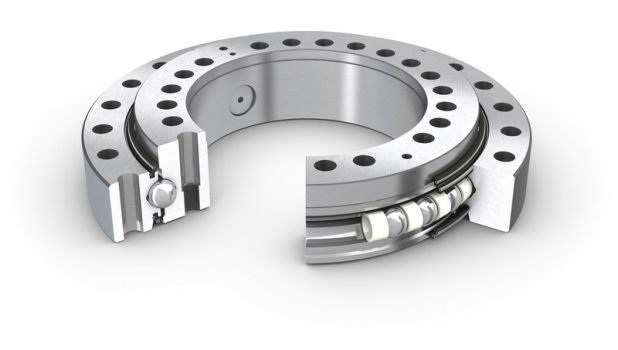Slewing Bearings

Slewing bearings comprise an inner ring and an outer ring, one of which usually incorporates a gear. Slewing ring bearings, or turntable bearings, are ball or roller style bearings composed of two concentric rings either of which may include a gear.
This type of bearing increases load stability and power transfer in both directions, and is usually used for sluggish applications and large machinery such as soil excavators and building cranes to support heavy loads. The rings are very large and typically have holes drilled in them to provide fixation to a frame relative to a ‘natural’ ball bearing. Between the rings, seals may be given to secure the rolling components. Slewing bearings are relatively small segments compared to other rolling-element bearings. Slewing rings range in size from as little as 100mm diameter to well over 15 000mm (often segmented at this size for easy transport and handling); for example the bearings on the Falkirk Wheel are 4 metres diameter and fit over a 3.5 metre axle. Slewing bearings are often made with gear teeth integral with the inner or outer race (or both ion rare cases) used to drive the platform relative to the base (for example in winches.
Slewing bearing designs range from single row ball or roller style, through double row ball or roller, triple row roller, combined (1 roller/ 1 ball) or wore guided raceways – each design having its own special characteristics and application. Old designs can have split rings to allow tight control on preload during assembly. As for other bearings that reciprocate, rather than rotating continuously, lubrication can be difficult. The oil wedge built up in a continuously rotating bearing is disrupted by the stop start motion of slewing. Instead, a hydrostatic bearing with pumped oil flow may be used.
Features & Benefits
Depending on their design, slewing bearings have the following features:
- High load carrying capacity
- High stiffness for rigid bearing application
- Low friction
- Long service life
- Surface protection and corrosion resistance
- Integration of additional features, including:
- Driving mechanism
- Control devices
- Lubrication systems
- Monitoring systems
- Sealing cassettes
Applications
The unique power and versatility of slewing ring bearings has made them increasingly valuable in a wide array of industries, including:
- Construction
- Industrial
- Robotics
- Machine tooling
- Medical applications
- Wind turbines
- Tunnel boring machines
- Excavators
- Forestry vehicles
- Rail vehicles
- Cranes
- Water treatment equipment
- Bottle filling systems, Metals
- Marine pods
- Offshore buoys
- Stacker reclaimers, Surveillance systems (e.g. radars, cameras)
- Medical equipment
- Tidal turbines